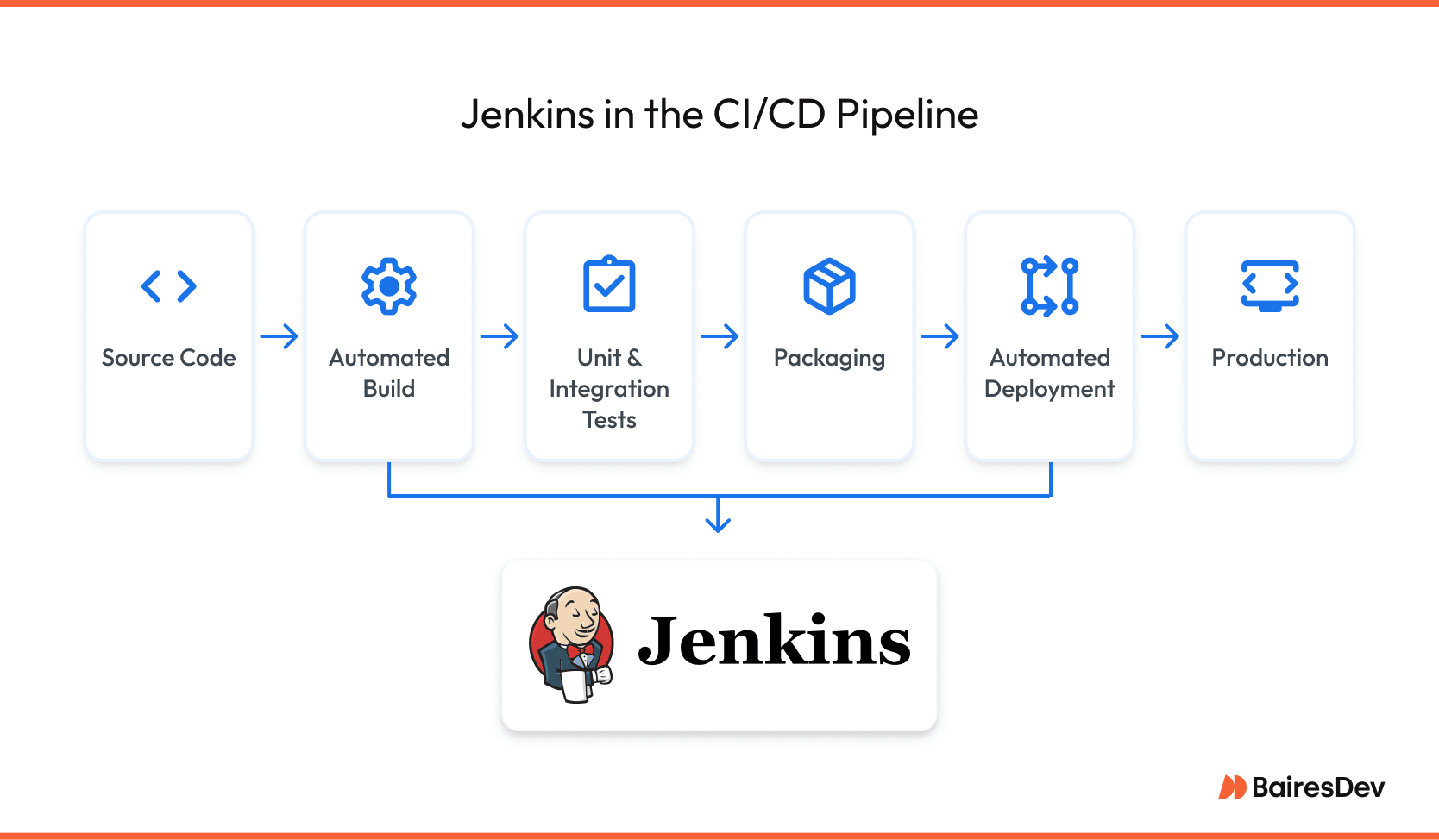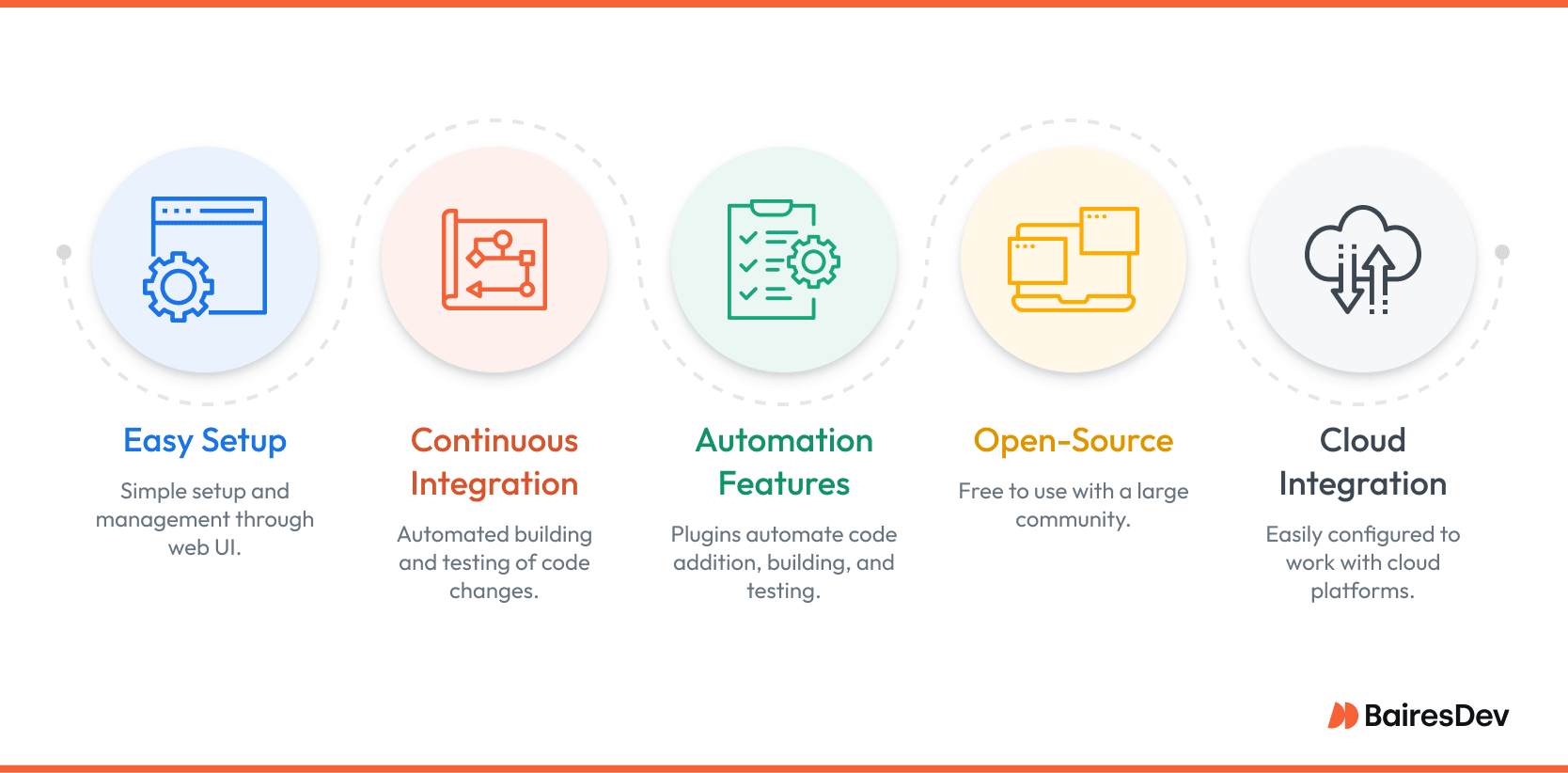Jenkins is an open-source automation server that runs on Java and includes a built-in web server. Jenkins is used to facilitate Continuous Integration and Continuous Delivery (CI/CD).
Jenkins essentially allows development teams speed up deployment, testing, and virtually every aspect of the development process. Features such as pipeline building and build testing make Jenkins an indispensable developer tool for large teams. In addition, Jenkins integrates with build tools such as Gradle and Maven, as well as containerization platforms like Kubernetes, and version control systems like Git and Subversion.
You can also integrate automation testing frameworks such as Selenium, Pytest, and Robot Framework, allowing for comprehensive testing and reporting as part of the CI/CD pipeline. It is commonly used to detect errors early in development and build process. Jenkins is used to generate detailed reports used to support quality assurance processes.
Jenkins currently has more than a million users and upwards of 2,200 active plugins that can help with coding, deployment, resource management, testing, and much more.
Jenkins supports all stages of the DevOps lifecycle through its plugins and has become an indispensable tool for thousands of software engineering teams. With over 300,000 active installations and millions of builds executed daily, Jenkins is used in the CI/CD pipelines of most Fortune 100 companies.
Introduction to Jenkins
Jenkins is an open-source automation server that lets developers build, test, and deploy software fast and reliably. Used throughout the software development lifecycle (SDLC), Jenkins supports continuous integration and continuous delivery, making it an essential tool for modern development practices and DevOps practitioners.
Designed as a platform-agnostic tool, Jenkins runs on all major operating systems—Windows, macOS, and Linux—making it accessible to virtually any development team.

What is Jenkins used for in the CI/CD pipeline? The short answer would be—almost everything, provided you use the right plugins. That’s why Jenkins decided to use an image of a butler for their logo.
Jenkins allows development teams to automate and monitor virtually all aspects of the CI/CD process, from code commit to deployment. It streamlines the entire software delivery process, enabling automated builds, automated tests, provisioning, and automated deployment. It also generates logs and test reports, allowing engineers to track the health of their builds.
By automating numerous repetitive tasks, Jenkins lets developers, QA specialists, and DevOps teams to focus on improving product quality and creating new features.
Who Created Jenkins?
Jenkins was created by Sun Microsystems’ developer Koshuke Kawaguchi. He realized that he had to continuously build and commit his code to the repository, even when the code had errors. To avoid that, he built an automation server in 2004 that could build and test his work and named it Hudson.
When Oracle acquired Sun Microsystems, tensions emerged between the open-source community and the company over governance and trademark control. Oracle eventually forked the project and rebranded it as Jenkins. For a short time, Hudson and Jenkins coexisted, but the broader community and key figures moved to Jenkins. The Hudson community shrank, and Oracle stopped actively developing. Jenkins became dominant due to its remarkable features and the backing of the open-source community.
Today, Jenkins is maintained by the Jenkins Project and governed by the Continuous Delivery Foundation (CDF), a part of the Linux Foundation. Jenkins development is ongoing, it remains open-source, and this is unlikely to change.
Automated CI tools like Jenkins have profoundly changed the SDLC. They are more cost-effective and efficient than traditional processes. With Jenkins, build management, source code management, analysis, automated and manual testing, provisioning, and much more can be controlled from a centralized platform.
What Makes Jenkins so Popular with DevOps Teams?
Let’s step back and explore why Jenkins is appreciated not just by enterprises chasing productivity gains, but real-world DevOps practitioners and software engineers alike.

- It’s easy to install and configure, as the Jenkins web UI allows easy setup and management.
- Jenkins enables continuous integration by automatically building and testing code in response to changes in the source repository. If the tests pass, Jenkins can automatically update the production library and trigger deployments to staging or production. If a test fails, Jenkins will notify the developer. Jenkins is a great choice for large-scale projects, making it a popular choice for enterprises and complex software systems.
- Jenkins also has many automation features and plugins that can automatically add new code to the repository and build and test it, saving your time and allowing the developers to focus on the business logic instead of testing, thereby enhancing CI/CD processes. This reduces project complexity, which, in turn, reduces project costs. This minimizes build time, and you can also easily understand the point of failure.
- It’s open-source and free to use. Jenkins is backed by a large community and one of its key strengths is the extensive plugin ecosystem, which was largely driven by its open-source nature and the enthusiasm of the Jenkins community. Updates, patches, and new features are released regularly.
- Cloud integration is another advantage worth noting. Jenkins is easily configured to work with popular cloud platforms such as Amazon EC2, Google Cloud Platform, VMWare vSphere, DigitalOcean, and many others.
How Jenkins Powers Continuous Integration Pipelines
Here is how Jenkins enables streamlined and scalable continuous integration pipelines.
- The engineer creates the code and submits it to the source code repository. You can edit the source file or create a new file for the project.
- The Jenkins server continuously monitors the repository for changes. Once it detects a new commit, it pulls the updated code and triggers a build job on the Jenkins server.
- The build server compiles the code and starts running unit tests. If the build passes, the workflow proceeds. Otherwise, logs, file details, and snapshots are sent to the concerned team and stakeholders. This can be done through various channels, such as Slack, Email, or Jira.
- If the build is successful, Jenkins can deploy it to a test environment, where additional automated tests can be executed. A feedback loop continuously updates the logs and reports failures. Jenkins can also take screenshots of failed tests to help with debugging.
- Once all tests pass, Jenkins can deploy the build to a staging or production environment. This depends on the workflow. The entire process is automated, and development teams can create highly customized pipelines tailored to their specific requirements.
When extended with automated deployments, this approach becomes part of a continuous delivery (CD) pipeline.
Jenkins Environment
A Jenkins environment typically consists of a Jenkins server, which is the central component that manages configuration, scheduling, and orchestration of jobs. The environment can also include build agents (nodes) which are essentially distributed machines tasked with executing Jenkins jobs. This distributed architecture allows Jenkins to distribute parallel workloads with greater efficiency.
Jenkins environments are highly customizable through various plugins and are configured using variables that store settings. Jenkins offers several built-in variables, and users can create additional global and local variables to meet their requirements.
What is a Jenkins Job?
A Jenkins job is a set of tasks or steps that are executed in a specific order to achieve a particular goal, such as building and testing a software project. The Jenkins server orchestrates these jobs, ensuring that each task is performed correctly and efficiently. Jenkins supports several job types, such as Pipelines, Multibranch Pipelines, and Freestyle projects.
These jobs are created, configured, and managed through the web user interface (UI). The Jenkins web UI also allows users to define job parameters, set up triggers, and monitor job execution, making it a powerful tool for managing automated workflows throughout the software development lifecycle.
What is the Jenkins Pipeline?
A Jenkins pipeline is a suite of plugins that allow organizations to improve their DevOps efficiency by defining every step of their software delivery process. Pipelines enable developers to implement continuous integration and continuous delivery practices in a structured and repeatable way.
The concept is called pipeline-as-code. A domain-specific language (DSL) is used to define the pipeline and written in a file called a Jenkinsfile. It is then stored in the same repository as the source, allowing pipeline configuration to be version-controlled like the source code. Jenkins supports two main types of pipelines: declarative and scripted.
- Declarative Pipelines feature a simple, structured format that is meant to be easy to read and follow.
- Scripted Pipelines use a more flexible and powerful syntax that enables complex logic.
Jenkins pipelines can also integrate with tools for static code analysis, deployment, testing, and auditing.
Through the Jenkins pipeline, you can create forks, conditional logic, modules, and looping constructs. You can also use pipelines to create an audit trail.
By enabling code-defined workflows, Jenkins pipelines help reduce manual errors, improve collaboration, and increase the overall resilience of the CI/CD process.
Continuous Integration and Continuous Delivery (CI/CD)
Continuous integration (CI) is the practice of frequently merging code changes into a shared repository, usually through automated processes. This approach helps to identify and address issues early in the development cycle, improving code quality, reducing integration challenges, and improving code quality.
Continuous deployment (CD) takes this a step further by automatically deploying code changes to production after they have been tested and validated. Jenkins supports both CI and CD by through its powerful pipeline automation capabilities. With Jenkins pipelines, developers can define the entire delivery workflow as code, from initial commit to final deployment. This results in a smooth, efficient, and repeatable software development process.
What are the Top Jenkins Plugins?
We already mentioned the importance of Jenkins plugins, and since there are more than 2,000 available at the time of writing, we cannot offer a detailed overview. Here are a few examples of popular plugins that greatly extend Jenkins’ functionality:
Dashboard View
This plugin allows you to create a customized dashboard for your Jenkins program. You can decide the specific jobs you want to monitor, track their status and completion, and visualize key metrics.
Monitoring Plugin
This plugin provides runtime monitoring of Jenkins instances and allows you to analyze metrics such as CPU Time, memory consumption, security issues, and thread activity. It also captures logs, thread dumps, and HTTP response codes to help engineers diagnose performance issues.
Kubernetes Plugin
Developers use this plugin to dynamically provision agents in a Kubernetes cluster. It helps scale the Jenkins agents through Kubernetes. It also adds an additional layer of automation to Jenkins and makes sure that the infrastructure defined by the developer is managed effectively.
Build Pipeline
This plugin allows you to visualize the sequence of Jenkins jobs in a pipeline and check the job flow for that particular build. You can check the triggers and successors for a particular job or set up reporting for triggered jobs. It’s important for DevOps processes that require you to check on different elements of the job structure simultaneously.
Jenkins Community and Support
Jenkins has a large and active community of users and developers committed to its growth and development. The Jenkins community provides support through various channels, online forums, documentation, and plugins.
Jenkins plugins are extensions that add functionality to the Jenkins server, such as integration with other tools and technologies. With over 2,200 plugins, the Jenkins community ensures the platform can be customized to any project’s needs. This support network makes it easier for developers to troubleshoot, share knowledge, and stay up to date with the latest Jenkins features.
Security in Jenkins
Security is a critical aspect of Jenkins, as it handles sensitive information such as source code, credentials, and deployment configurations. Jenkins provides several built-in features to ensure that only authorized users can access and manage jobs and system settings.
These features include authentication and authorization mechanisms that control user access based on roles and permissions. It also supports encryption and secure protocols like HTTPS and SSH to protect data in transit. Jenkins integrates with external identity providers such as LDAP, Active Directory, and OAuth.
By implementing these security measures, Jenkins helps ensure that the software development process and delivery remain secure, traceable, and compliant.






